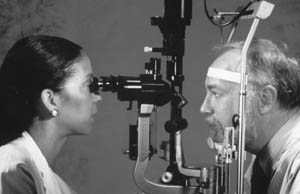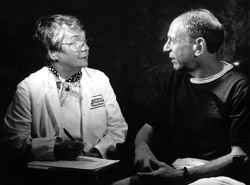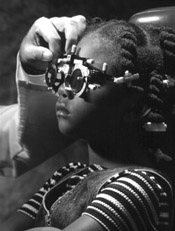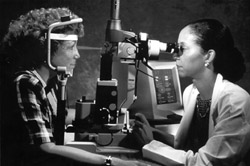Clinical Trials in Vision Research
On this page:- What is a clinical trial?
- What kinds of clinical trials are there?
- Where do clinical trials take place?
- How is a clinical trial conducted?
- What is expected of patients in a clinical trial?
- What are the benefits of participating in a clinical trial?
- What are the risks?
- How is patient safety protected?
- What are a patient's rights in a clinical trial?
- What about costs?
- What questions should you ask before deciding to join a clinical trial?
- What clinical trials are being held? Who can take part in them?
- What is the National Eye Institute?
If you or someone you know is thinking about taking part in a clinical trial, this booklet can answer some of your questions. The National Eye Institute (NEI) conducts or sponsors clinical trials to find new ways to treat or prevent eye disease and vision loss. Clinical trials in vision research have led to new medicines and surgeries that have saved or improved sight for thousands of people.
What is a clinical trial?
Clinical trials involve medical research with people. Most medical research begins with studies in test tubes and in animals. Treatments that show promise in these early studies may then be tried with people. The only sure way to find out whether a new treatment is safe, effective, and better than other treatments is to try it on patients in a clinical trial.
What kinds of clinical trials are there?
Clinical trials are carried out in three parts, or phases.
- Phase I. Researchers first conduct Phase I trials in small numbers of patients and healthy volunteers. If the new treatment is a medicine, researchers also want to find out how much of it can be given safely.
- Phase II. Researchers conduct Phase II trials in small numbers of patients to find out the effect of a new treatment on an eye disease or disorder.
- Phase III. Finally, researchers conduct Phase III trials to find out whether the new treatments work better, the same, or not as well as the standard treatments already being used. Phase III trials also help to determine if new treatments have any side effects. These trials--which may involve hundreds, perhaps thousands, of people around the country--can also compare new treatments with no treatment.
Where do clinical trials take place?
The NEI supports clinical trials at about 250 medical centers, hospitals, universities, and doctors' offices across the country. NEI researchers conduct other clinical trials at the National Institutes of Health in Bethesda, Maryland.
How is a clinical trial conducted?
At each facility taking part in the clinical trial, the principal investigator is the researcher in charge of the study. Most of the people who conduct clinical trials in eye disease are ophthalmologists or optometrists. The clinic coordinator knows all about how the study works and makes all the arrangements for your visits.
Treatment for Herpes of the Eye
The Herpetic Eye Disease Study (HEDS) is an example of a Phase III treatment trial. Herpes of the eye, which is controllable but incurable, can produce a painful sore on the eyelid and inflammation of the cornea, the transparent tissue on the surface of the eye. Previous studies showed that once people develop ocular herpes, they have up to a 50 percent chance of having a recurrence. In one part of the HEDS, researchers followed 703 patients who had herpes of the eye during the preceding year, but did not currently have an active case of the disease. Of this number, 357 were treated with the antiviral drug acyclovir by mouth, and 346 received a placebo.
Results: Scientists found that acyclovir reduced by 41 percent the probability that herpes of the eye would return. The findings from this research have helped to change how doctors treat the disease.

All doctors who take part in the study carefully follow a detailed treatment plan called a protocol. This plan fully explains how the doctors will treat you in the study. The protocol ensures that all patients are treated in the same way, no matter where they receive care.
- Clinical trials are controlled. This means that researchers compare the effects of the new
treatment with those of the standard treatment. In some cases, when no standard treatment
exists, the new treatment is compared with no treatment.
- Patients who get the new treatment are in the treatment group.
- Patients who get the standard treatment or no treatment are in the control group.
- In some clinical trials, patients in the treatment group get a new medicine and patients in the
control group get a placebo. A placebo is a harmless substance--a "dummy" pill--that looks like
the real treatment but has no effect on the eye disease or disorder. In other clinical trials, where
a new surgery or device (not a medicine) is being tested, patients in the control group may
receive a sham treatment. This treatment, like a placebo, has no effect on the eye disease or
disorder and does not harm patients.
- Researchers assign patients randomly to the treatment or control group. This is like flipping a
coin to decide which patients are in each group. Patients do not know ahead of time which
group that is. The chance of any patient getting the new treatment is about 50 percent. Patients
cannot request to receive the new treatment instead of the placebo or sham treatment. In some
clinical trials, where the disease or disorder affects both eyes, one eye may be in the treatment
group, and the other eye may be in the control group.
- Patients often do not know until the study is over whether they are in the treatment group or the control group. This is called a masked study. In some trials, neither doctors nor patients know who is getting what treatment. This is called a double masked study. These types of trials help to ensure that what patients or doctors might think about the treatment will not affect the study results.
What is expected of patients in a clinical trial?
Patients in a clinical trial are expected to have eye exams and other tests. You may also need to take medications and/or undergo surgery. Depending upon the treatment and the examination procedure, you may need a hospital stay.
You may have to go back to the medical facility later for followup examinations. These exams help find out how well the treatment is working. Followup studies can take months or years. However, the success of the clinical trial often depends on learning what happens to patients over a long period of time. Only patients who continue to return for followup examinations can provide this important long-term information.
Natural History Studies
Unlike clinical trials, in which patient volunteers may receive new treatments, natural history studies provide important information to researchers on how certain eye diseases or conditions develop over time. A natural history study follows patient volunteers to see how factors such as age, sex, race, or family history might make some people more or less at risk for certain eye diseases or disorders. A natural history study may also tell researchers if diet, lifestyle, or occupation affect how a disease or disorder develops and progresses. Results from these studies provide information that helps answer questions such as: How fast will a disease or disorder usually progress? How bad will vision become? Will treatment be needed?

What are the benefits of participating in a clinical trial?
Participating in a clinical trial can bring many benefits:
- There is the hope that a new treatment will be more effective than the current treatment for an eye
disease or disorder. Only about half of the people in a clinical trial get the new treatment. If the new
treatment is effective and safer than the current treatment, those patients who do not receive the
new treatment during the clinical trial may be among the first to benefit from the new treatment
when the study is over.
- If the treatment is effective, it may help to improve vision and control or prevent eye disease or
disorder.
- Clinical trial patients receive the highest quality medical care. Experts watch them closely during the
study and may continue to follow them after the study is over.
- People who take part in these trials contribute to new knowledge that may help other people with the same eye problems. In cases where certain eye diseases or disorders run in families, your participation may lead to better care for family members.
The Informed Consent
Once you agree to take part in a clinical trial, you will be asked to sign an informed consent. This document explains a clinical trial's risks and benefits, what researchers expect of you, and your rights as a patient.

Clinical trials may involve risks as well as possible benefits.
- Whether or not a new treatment will work cannot be known ahead of time. There is always a chance that a
new treatment may not work better than a standard treatment, may not work at all, or may be harmful.
- The treatment you receive may cause side effects that are serious enough to require medical attention.
How is patient safety protected?
Clinical trials can raise fears of the unknown. Understanding the safeguards that protect patients can ease some of these fears.
- Before a clinical trial begins, researchers must get approval from their hospital's Institutional Review
Board (IRB), an advisory group that makes sure a clinical trial is designed to protect patient safety.
-
During a clinical trial, doctors will closely watch you to see if the treatment is working and if you are having
any side effects. All the results are carefully recorded and reviewed.
-
A group of experts--the Data and Safety Monitoring Committee--carefully watches each clinical trial
supported by the NEI. This group can recommend that a study be stopped at any time.
- Patients are asked to take part in a clinical trial only if they volunteer and understand the risks and benefits.
What are a patient's rights in a clinical trial?
Patients who are eligible for a clinical trial will be given information to help them decide whether to take part. As a patient, you have the right to:
- Be told about all known risks and benefits of treatments involved in the study.
- Know how the researchers plan to carry out the study, for how long, and where.
- Know what is expected of you.
- Know any costs involved for you or your insurers.
- Be informed about any medical or personal information that may be shared with other researchers directly
involved in the clinical trial.
- Talk openly with doctors and ask any questions.
After you join a clinical trial, you have the right to:
- Leave the study at any time. Participation is strictly voluntary. However, you should not enroll if you do not
plan to complete the study.
- Receive any new information about the new treatment.
- Continue to ask questions and get answers.
- Maintain your privacy. Your name will not appear in any reports based on the study.
- Be informed of your treatment assignment once the study is completed.
Uncovering an Ineffective Treatment
Decompression surgery was once thought to be a sightsaver for people with ischemic optic neuropathy, a swelling of the optic nerve. An NEI-sponsored clinical trial examined this surgery in 244 patients.
Results: The operation proved to be neither safe nor effective. In addition, nearly half of those who did not have the surgery had improved eyesight within 6 months. Because of these results, the NEI stopped the study earlier than expected and mailed a special bulletin to 25,000 doctors.
In some clinical trials, the medical facility conducting the research pays for treatment costs and some other expenses. You or your health insurance may have to pay for some things that are considered part of standard care. These things may include hospital stays, laboratory and other tests, and medical procedures. You also may need to pay for travel between your home and the clinic. For clinical trials conducted at the NEI's medical facility in Bethesda, Maryland, medical care is provided at no cost to patients. You should find out about costs ahead of time. If you have health insurance, find out exactly what it will cover. If you don't have health insurance, or if your insurance company will not cover your costs, talk to the clinic staff about other options for covering the cost of your care.
Saving the Sight of Premature Infants
Retinopathy of prematurity (ROP) occurs when abnormal blood vessels grow and spread throughout the retinas of premature infants. The disorder mostly affects infants who weigh less than 3 pounds at birth. The NEI sponsored a clinical trial to find out whether a procedure called cryotherapy was a safe and effective treatment to prevent ROP. In this procedure, doctors briefly touch spots on the surface of the eye with an instrument called a cryoprobe. This freezes parts of the retina to stop the growth of abnormal blood vessels.
Results: Fewer of the infants' eyes that were treated with cryotherapy became blind compared with the eyes of untreated infants. Researchers continue to follow these children to gain information about the long-term

What questions should you ask before deciding to join a
clinical trial?
Questions you should ask when thinking about joining a clinical trial include the following:
- What is the purpose of the clinical trial?
- What are the standard treatments for my disease or condition? Why do researchers think the new treatment may be better? What is likely to happen to me with or without the new treatment?
- What tests and treatments will I need? Will I need surgery? Medicines? Hospitalization?
- How long will the treatment last? How often will I have to come back for followup exams?
- What are the treatment's possible benefits to my condition? What are the short- and long-term
risks? What are the possible side effects?
- Will the treatment be uncomfortable? Will it make me feel sick? If so, for how long?
- How will my health be monitored?
- Where will I need to go for the clinical trial? How will I get there?
- How much will it cost me to be in the study? What costs are covered by the study? How much will my health insurance cover?
- Will I be able to see my own doctor? Who will be in charge of my care?
- Will taking part in the study affect my daily life? Will I have the time to be in it?
- How do I feel about taking part in a clinical trial? Are there family members or friends who may benefit from my contributions to new medical knowledge?
Laser Treatment for Diabetic Retinopathy
Two NEI-sponsored clinical trials examined the use of laser treatment in patients with diabetic retinopathy, a disease that damages the blood vessels in the retina. About half of the 16 million Americans with diabetes have this disorder, which is a leading cause of blindness in working-age adults. Laser treatment was given to 4,453 people with diabetes at 25 medical centers. One eye of each patient received laser treatment. The other eye was not initially treated.
Results: Laser treatment was very effective in preventing vision loss in more than 90 percent of patients with diabetic retinopathy.

What clinical trials are being held? Who can take part in them?
The NEI conducts or sponsors research on many eye diseases and disorders. Because funding for eye research goes to the medical areas that show promising research opportunities, it is not possible for the NEI to sponsor clinical trials in every eye disease and disorder at all times.
Not everyone can take part in a clinical trial for a specific eye disease or disorder. Each study enrolls patients with certain features, or eligibility criteria. These criteria may include the type and stage of disease or disorder, as well as the age and previous treatment history of the patient.
You or your doctor can contact the NEI to find out more about specific clinical trials and their eligibility criteria. If you are interested in joining a clinical trial, your doctor must contact one of the trial's investigators and provide details about your diagnosis and medical history.
The NEI's Website lists the clinical trials the NEI is helping to support. Each trial description includes information on its background and purpose, as well as patient eligibility. There is information on how to participate in a trial and how to refer a patient to a trial.
Preventing Blindness in People with AIDS
Many people with AIDS have an eye infection known as CMV retinitis. Drugs such as ganciclovir can control the infection and reduce the chance of blindness. In the past, doctors gave the drug through a tube that had to remain in a vein. It took 2 hours to give each dose. Another way to give ganciclovir is through the use of a tiny implant in the eye. The implant slowly releases the medication for several months. The NEI supported a clinical trial to find out whether this implant was safe and effective.
Results: Almost all of the eyes treated with the implant had complete control of their eye infection and maintained nearly perfect vision. The implant also improved the patients' quality of life by making treatment easier.
What is the National Eye Institute?
The National Eye Institute (NEI) is one of the Federal government's National Institutes of Health. It was established by Congress in 1968 to discover safe and effective ways to prevent, diagnose, and treat eye diseases and disorders. The NEI is the major sponsor of vision research in the United States. For more information about the NEI, contact:
National Eye Institute
2020 Vision Place
Bethesda, MD 20892-3655